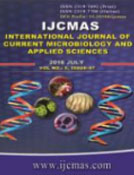


 National Academy of Agricultural Sciences (NAAS)
National Academy of Agricultural Sciences (NAAS)

|
PRINT ISSN : 2319-7692
Online ISSN : 2319-7706 Issues : 12 per year Publisher : Excellent Publishers Email : editorijcmas@gmail.com / submit@ijcmas.com Editor-in-chief: Dr.M.Prakash Index Copernicus ICV 2018: 95.39 NAAS RATING 2020: 5.38 |
One poly- β-hydroxybutyrate producing bacterial from different microbial sources was isolated and characterized for their morphological, biochemical properties. Based on their 16S rDNA, it was identified as Bacillus cereus E6. The bacterial strain was screened for PHB production and compared for the intensity of fluorescence using Nile red staining method. PHB production conditions were optimized with different carbon and nitrogen sources, the highest PHB production was observed with sucrose and ammonium sulphate by B. cereus, respectively. Regarding incubation time as well as temperature and pH, optimum PHB production conditions were 48 h, 30 °C and 7, respectively. B. cereus is capable of accumulating appreciable levels of PHB from glucose, xylose, lactose, whey, molasses, sugar cane bagasse, rice straw hydroysate when 2% from all substrates were used an alternative carbon for the PHB production. Ammonium sulphate was the best nitrogen source. C/N ratio was also one of the factors that affected the production of PHB. The ratio of C/N that reaches 20:1 was considered the best ratio to produce the highest production of PHB. The present study provide the useful data about the optimized conditions for PHB production by B. cereus that can be utilized for industrial production of PHB, a fast emerging alternative of non-biodegradable plastics.
 |
 |
 |
 |
 |